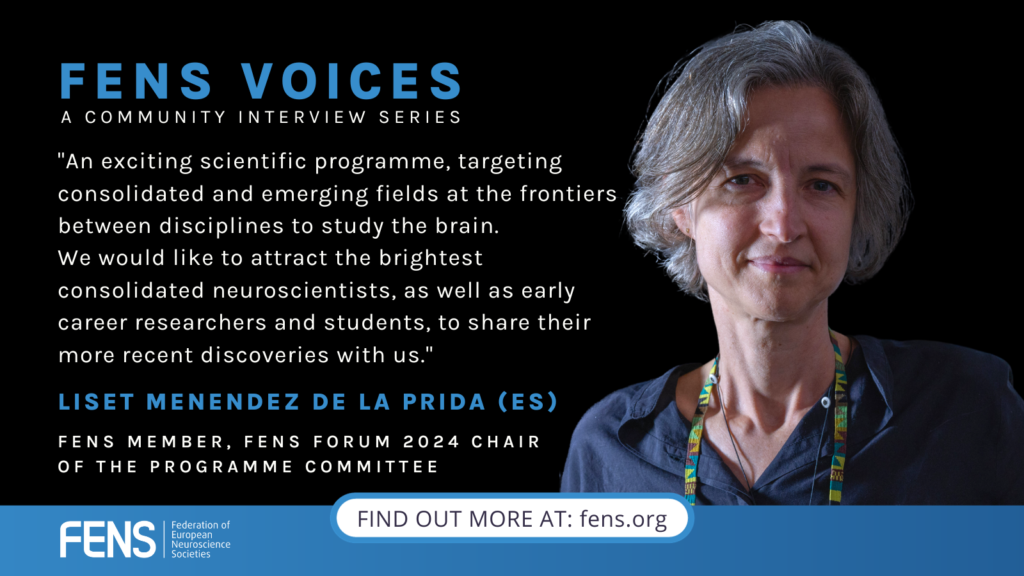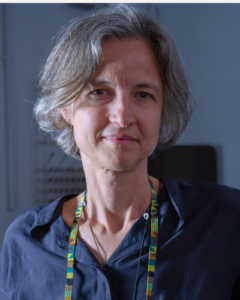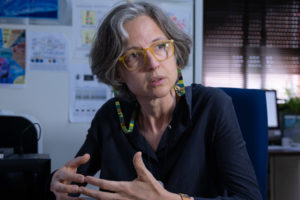
FENS Voices | Liset M. de la Prida: A sense of community
22 September 2023
FENS News, Neuroscience News
As the FENS Forum 2024 programme is coming into focus, FENS Voices thought it was a good time to find out more about our Programme Committee Chair, Dr Liset M. de la Prida, and what to expect next year in Vienna (25-29 June). Dr de la Prida graduated in Physics in 1994 and received her PhD from the Institute of Neuroscience in Alicante in 1998. After completing her postdoc alongside Prof. Richard Miles in Paris, she became Lab Director at the Instituto Cajal in 2008. She is the recipient of numerous awards and has earned prestigious fellowships and grants from EMBO, HFSP and the European Commission under different framework programmes. The main goal of her lab is to understand the function of hippocampal and parahippocampal circuits. She is a leading international expert in the study of the basic mechanisms of physiological ripples and epileptic fast ripples, with strong visibility as a developer of novel groundbreaking neurotechnologies. Dr de la Prida serves as an Editor for specialised journals such as the Journal of Neuroscience Methods, eLife and eNeuro and has commissioning duties in the American Epilepsy Society (Task Force Working Groups) and the Spanish Society of Neuroscience. Read the full interview below.

When did you become interested in science and how did it evolve as your passion?
LMP: I have always liked science, ever since I was a kid. My father is a researcher and I remember looking at his graphics and scientific plots and getting trapped by their beauty. I used to play drawing similar graphs, imagining I was a scientist myself. Later, as a teenager, I was eager to read any kind of book, but there was that collection of physics books that convinced me of what my passion was. Studying physics was like a natural choice for me, something that has been in my mind since I can remember. It is the most beautiful of the sciences, the most complete. To me, it blends the exact proportion of reality, mathematics and rationalism and can be applied to everything.
You studied Physics in La Habana and during your studies you grew an interest in complex systems. How did your focus change to neuroscience?
LMP: If you live in the Caribbean as a child, it is easy to become familiar with the storms and hurricanes. These are part of my early memories. The afternoon storms shape along the day, while the sun heats the air around. These evolve by interacting with the ocean and sometimes become unpredictable. The first thing I liked studying was the relationship between the storms and the sea. The weather is a complex system, which can be modeled using a set of differential equations and a state space. And I loved all that. Then I got in contact with neuroscience and learnt you can also use differential equations to model brain activity. This was in the early 90’s and the idea of the brain as a complex system was circulating. I remember reading some papers in Nature and Science in the library of the university. It was a time when there were discussions over applying chaos theory to predict and control brain activity and using dynamical systems to model small neuronal circuits. I discovered something new there, more closely related to philosophical questions about the self and consciousness. So, it was another natural step for me.
How was your PhD experience and why did you decide to study at the Instituto de Neurociencias de Alicante, Spain? What were the most useful lessons you learned?
LMP: I got a fellowship to develop my PhD studies at the Instituto de Neurociencias. That offered me the opportunity to try experiments myself, which changed my vision drastically. Combining computational models and analysis of electrophysiological signals dragged me into a new realm. I learnt to be more flexible regarding my theories, to better accommodate experimental evidence. I also learnt a unique combination of skills, impaling single cells, making the brain slice preparation to work and dealing with experimental contingencies. I moved from a purely theoretical to an experimental framework and that shaped my vision definitively.
After your postdoctoral research, you established your own lab at the Instituto Cajal, where you currently try to understand the function of the hippocampal and para-hippocampal circuits in the normal and the epileptic brain. Why did you choose to focus on hippocampal oscillations?
LMP: The brain is a complex dynamic system that generates a hierarchy of oscillations. The hippocampal oscillations provide a good model to understand how memories and representations are created in the brain. When I started my own lab, I chose to tackle this problem in health and disease. You learn a lot about the regular brain by studying the diseased brain and epilepsy research has contributed significantly to our current models of memory. So, I moved into in vivo recordings of hippocampal oscillations to better understand how they link to memory function and dysfunction, for temporal lobe epilepsy. That research programme took me about 12 years to complete. We were among the first to obtain single-cell and precise laminar recordings from the hippocampus of diseased rodents, such as epileptic rats and mice. We confronted changes in the natural oscillations with the cognitive ability of these animals to remember events that happened at some place, at some time. We used to talk about rhythmopathies to refer to the changes occurring in the diseased hippocampus in a range of natural oscillations, like theta, gamma and ripples. This approach has turned out to be extremely useful to functionally phenotype microcircuit dysfunction caused by different mechanisms, but it also highlighted my interest in normal oscillations and their relationship with the underlying microcircuit.

You are interested in computational modelling and in artificial learning technologies. How are you using AI brains in your lab?
LMP: I always combined computational models and experimental data analysis, but something changed drastically after we started playing with unsupervised approaches to categorise hippocampal oscillations. After a long time working with spectral analysis, we started feeling a bit frustrated. We noticed subtle differences in the expression of a range of oscillations, which could not be captured in spectral terms only. One example is ripples, a high frequency oscillation coming in tandem with sharp waves. Sharp-wave ripples are thought to be relevant for memory consolidation. They relate to one of the most intriguing phenomena of the hippocampus, which is replay. During replay, neurons fire in sequences representing recent experiences and single-cell studies have reported cell-type-specific firing selectivity. In epileptic rodents, these ripples are distorted and become faster, but some of them are not distinguishable from normal ripples. So, we discovered that by using different AI strategies we could extract more information about this variability. We have also started expand our ability to record from many more cells and regions, going from local to brain-wide circuits. We feel the brain builds representations as a whole, so we need to see beyond the hippocampus. Applying machine learning tools to understand brain activity is transformative. It is like closing a loop, AI gets inspired by the brain and, in turn, it helps us understand the brain back.
Besides brain research, you are the Chair of the FENS Programme Committee 2022-2024. What made you dedicate your time to FENS activities?
LMP: A sense of community. I served on the previous FENS Programme Committee for the FENS Forum 2022 in Paris. This is beautiful work, because you help shape the scientific programme alongside your other colleagues. We gather and bring diverse backgrounds on how to study the brain. During the meetings, you feel this complementarity that different views can offer. Then, when we receive the symposium proposals from our peers, we can hear the community and learn about the current trends in the field. This is exciting. It is a lot of work, but totally worth it.
FENS Forum 2024 will take place on 25-29 June 2024 in Vienna, Austria. What should we expect from the next Forum’s scientific programme?
LMP: You should expect an exciting scientific programme, targeting consolidated and emerging fields at the frontiers between disciplines studying the brain. We want to reflect the diversity of our society in terms of topics and scientists. We would like to attract the brightest consolidated neuroscientists, as well as early career researchers and students, to share their more recent discoveries with us.
A large part of FENS Forum participants are students and early career researchers. Why is the FENS Forum important for early career researchers?
LMP: Science is a social activity; we build knowledge in a community. The FENS Forum offers a platform to engage with other colleagues from around the world and to gain knowledge, ideas and insights from more experienced researchers. It provides unique opportunities for early career researchers to network, learn about cutting-edge research and connect with others. Additionally, it is a fantastic way for them to make international contacts, which can be invaluable when it comes to developing research collaborations and advancing their careers. Apart from scientific sessions, we will have several other activities, from career development, networking and the most exciting party – Jump the FENS! So, I am sure they will not want to miss this conference.
About the FENS Forum
The FENS Forum of Neuroscience is the largest international neuroscience meeting in Europe, occurring biennially on even years and covering all fields of neuroscience research from basic to translational. The FENS Forum 2024 will bring together experts in all fields of neuroscience to take us to the forefront of our current understanding of modern brain science. It will take place on 25-29 June 2024 in Vienna, Austria.
About the Federation of European Neuroscience Societies (FENS)
Founded in 1998, the Federation of European Neuroscience Societies is the main organisation for neuroscience in Europe. It currently represents 44 national and single-discipline neuroscience societies across 33 European countries and more than 22,000 member scientists. Discover FENS and subscribe to our biweekly News Alert, with information on our latest calls and activities. Find out how to become a FENS member and join the neuroscience community!